
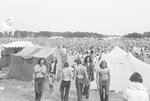
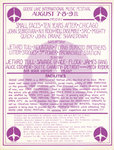
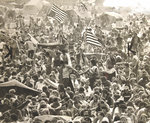
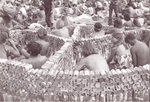

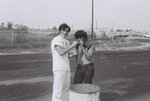
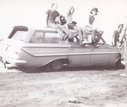
Learn more about the festival's legendary lineup of bands here.
Goose Lake? Never heard of it. Where is it? Somewhere near Jackson.
Why would anyone want to hold an A-List rock concert so far off the beaten path?
That was the conversation I had with a friend in Michigan State University’s School of Criminal Justice when he asked me and two other friends if we wanted to work security at a rock concert. The answer would’ve been no except the organizers were paying $300 for five days work.
So, there I was: 50 years ago on Aug. 7, 8 and 9 standing at the front gate of this massive 370-acre park. I was taking poker chips embossed with the Goose Lake Jamboree International Music Festival logo, which were used in place of easily counterfeited paper tickets. The organizer, Dick Songer, had met us a day before the gates opened so we could familiarize ourselves with the layout.
Songer may not have had “unlimited capital” like the organizers of Woodstock, but he did seem to have unlimited resources. The 35-year-old road contractor earned a wad of money building overpasses and entry ramps for the State Highway Department. He also owned heavy equipment like road graders and trucks, which he used to sculpt marshes and meadows into a playground for hippies just off I-94 east of Jackson in Leoni Township. A map handed to festival-goers listed hippy-dippy sites like “Toke-a-Lot,” “Goosenest,” “Movement Meadow” and “Biker Acres.”
The festival site bordered on a small lake for swimming and bathing, which some people decided to enjoy in the nude. Songer constructed concession stands, bathrooms, coed showers, a giant slide, surface parking, a food service area and — most amazingly —a stage on a turntable, which allowed quick turnaround between sets. When one band’s set was finished roadies would manually rotate the stage with the next band already set up and playing. Savvy organizers had seen what happened at Woodstock, where bands took an hour or more to transition between sets. Woodstock had a similar turntable, but it broke early.
Songer had appeared to cover all the bases, including mounted security to patrol the fence-line and a coterie of Detroit bikers to help cool fans who came on motorcycles. When I was told one of my duties was to watch over the bikers, I could think of only one word: Altamont, the infamous 1969 open-air concert where the Hells Angels killed a concert-goer. The bikers at Goose Lake were a little more laid-back, and their muscle came in handy several times when some motorcyclists resisted being sent to Biker’s Acres, where they were designated to camp.
When the gates opened the day before the festival, car after car backed up at the three gates and many not wanting to wait left their cars parked on the side of the road. I still remember one car riding on the rims through the entrance.
On the whole, the festival was well-organized. Songer erected a chain-link fence around the entire site, as he had no intention of having a second Woodstock, where fans got in without paying by the masses. Several times a day, he would drive his Cadillac to the entrance sites, collect poker chips and dump them into the car’s trunk. He was no dummy. He knew some ticket-takers would pocket chips and sell them outside the fence-line at a discounted price. It happened.
Many of the fans wanted to keep their chips as souvenirs, and refused to give them back to Songer. The answer: “Hand it over.” Today, those chips are sold on eBay for $6. They are not that rare.
Some of the Goose Lake attendees I spoke with had memories clouded by drugs and just the sheer passage of time. However, most festival-goers remember the long lines for food and bathrooms, and the seemingly unlimited makeshift bazaar of entrepreneurs working out of trunks and vans selling everything from marijuana, hash, acid and laughing gas, along with water, Coca-Cola, watermelons and wine. I was surprised at how many remembered the giant peace sign constructed out of beer and pop cans.
As the first day came to a close, a kind of calm settled over the festival grounds while speakers played top 40 music. “Fire and Rain” must have played 100 times during the three days. And since wood was free, campfires abounded and blazing fires shadowed dancers at nightfall. Fortunately, there was no rain over the three days, but there was little shade. When the temperature climbed, men and women began wearing fewer clothes and searched for a place to bathe.
The choices for cleaning up were either Goose Lake itself or cold coed showers. Drugs took the edge off both.
Jaan Uhelszki had only recently graduated from high school and was working at a suburban mall head shop and edging to get a job at Creem magazine when she made the trip from Detroit to Goose Lake Jamboree International Music Festival.
“I felt I was with my people. It was my coming-of-age and I felt liberated,” she said.
Uhelszki, whose persistence ended up with her eventually becoming a senior editor at Creem, said it was the first time she slept in a tent and the first time she was dosed by a bad drug, and hopefully the last. Many of her friends also reported being “dosed” by bad acid, she said.
Overall, the attendees felt a sense of being at something “larger.”
Steven R. Butts was a 19-year-old working at Knapps Department Store in downtown Lansing, and he would hang around during his lunch hour across the street at the eclectic Free Spirit, “a community of boutiques.” He said it’s likely that’s where he and his friends bought their tickets.
“I bought a lot of records at Sounds and Diversions,” he said.
When Butts, now living in Lake Odessa, arrived at Goose Lake with a group of friends he couldn’t believe the masses of people.
“We were a long way from the stage. Everyone was like-minded. There was nothing divisive and everyone shared and shared alike,” he said.
He also clearly remembers the drug sellers’ row, where van after van parked — double doors wide-open — selling marijuana, hash, acid and balloons of laughing gas. Some books and reports indicated the open sale of heroin and other hard drugs.
Butts recalls the tremendous array of bands, especially the big sound of Chicago and The Flying Burrito Brothers.
“I levitated. Goose Lake gave me the impetus to go to California. I just took off,” he said.
Dick Rosemont, co-founder of Flat, Black & Circular in East Lansing, was among the hundreds of volunteers from local bands recruited by Russ Gibb concert promoter and impresario at Detroit’s Grande Ballroom, who also booked the bands for Goose Lake.
Volunteers like Rosemont got in for free and were given a color-coded T-shirt, but were mostly on their own when it came to supervision.
Rosemont recalls helping people set up tents and later hanging around the medical tent, which helped about 500 festival-goers through drug overdoses and tended to cuts and abrasions. No one died at Goose Lake, but one attendee took a nosedive off one of the giant sound towers and sustained some broken bones.
Rosemont was then assigned to act as a guard at the top of the tower to keep attendees from getting up there.
“I’m not a huge fan of heights, but I went up there with a bottle of wine and binoculars,” he said. “You have to give Songer credit, he attempted to do it right.”
“There was food and it was cheap, but there just wasn’t enough. There were bathrooms, just not enough of them,” Rosemont added.
Songer put in a big slide, and there was a completely outfitted head shop in a semi-truck where you could buy pretty much any smoking paraphernalia.
A lot of young women according to Uhelszki had complaints about the public coed showers since gawkers were everywhere. Not the best of memories.
Tom Weschler was a roadie for Bob Seger and had seen a lot of stages across the country, but he was impressed with the operation of Goose Lake International Music Festival. He said, for most of the bands at Goose Lake, it would be the first time they would play before such a massive crowd, which was estimated at more than 200,000
Songer, right from the get-go, went to the principals at the Grande Ballroom: Russ Gibb and Tom Wright. Gibb was responsible for booking the festival’s impressive array of national bands like Chicago and Rod Stewart and Faces, while including a nice mix of Detroit area bands like Mitch Ryder and Brownsville Station.
Tom Wright, who managed the operation at the Grande Ballroom, totally oversaw the stage area, backstage and sound systems. It was his idea to use the turntable stage where one band set up while the other was playing their set.
“It was an amazing setup, more efficient than Woodstock,” Weschler said.
While there, Weschler shot photos of Seger onstage, which later appeared in his award-winning rock photography book, “Travelin’ Man.” He was also asked if he wanted to sell “coke,” laughing he said: “We did pretty good selling Coca-Cola. A guy called the Watermelon Man had brought up a truckload of melons from Georgia, where he had paid 50 cents per melon. He did a brisk business at $5 a pop. Others were retailing Boone’s Farm and Ripple.”
Because of her time at Creem, Third Man Records reached out to Jaan Uhelszki to write the liner notes for a remastered version of The Stooges performance at Goose Lake. Her 4,000-plus words are absolute genius, which is to be expected coming from a rock critic who, in full makeup and costume, played a concert with Kiss.
Joe Salem, dean of MSU Libraries and Archives, said he’ll be one of those waiting in line to buy the ‘new’ Stooges vinyl when it’s released Saturday on the 50th anniversary of the group’s appearance at Goose Lake.
Earlier this year, MSU Special Collections received a massive collection from Jack and Melissa Bodnar of Michigan-related music items, including numerous objects from Goose Lake, such as poker chips, photographs, bumper stickers, posters, T-shirts and the rare four-colored comic book “Goose Lake Gags,” drawn by rock poster artist Gary Grimshaw.
Salem said it’s important to collect items and memories from these mass gatherings.
“I grew up as a fan of Woodstock, and Goose Lake was the Midwest’s Woodstock,” he said. “The ’60s were not peaceful times, but collections help us celebrate peaceful times and how mass amounts of people helped create a microculture.”
Jaan Uhelszki, who calls herself a “stickler for accuracy,” said when we recall events like Goose Lake, we have to be careful that they aren’t just a reflective memory. Like the guy who rolled a joint with what looked like a quarter pound of marijuana in a newspaper and connected it to a gas mask. Yes. It really did happen. Or did it?
Attendee memories differ so broadly partly because of the size of the venue. Some say drugs. Clearly some areas were rowdier than others. Uhelszki writes about the turmoil backstage in her liner notes.
She writes how the area directly surrounding the stage was one of those trouble spots. Organizers had erected a chain-link fence and a moat-like ditch to separate the bands from the rowdy fans, and, in Iggy Pop’s case, vice-versa. Uhelszki's liner notes, which go much deeper into detail, are not to be missed. Her lyrical reporting will have you longing for an issue of Creem magazine.
Expecting trouble for the Stooges’ performance, a robust group of volunteers and security rimmed the stage area. For a short period there was pandemonium.
Uhelszki writes in her notes that as the crowd at the front, which few other fans saw, got more unruly toward the end of The Stooges’ performance, Tom Wright used the turntable to bring the band Third Power front and center, and when the crowd looked like they were going to tear the fence down they began playing the Christmas song “Little Drummer Boy.” In a moment of peace, tens of thousands of fans lit matches and lighters.
Ray Walsh, proprietor of Curious Books in East Lansing, also attended Goose Lake. He was there representing A&M Records, his part-time job at the time. He packed a bunch of friends in his 1963 Rambler and took off for Goose Lake. While on his way, he was stopped by the police and ticketed for having too many riders in the front seat.
At the festival grounds, there were definitely undercover police but they mostly stayed out of the way. It was only after the festival ended that police busted festival-goers for drug possession. Teegarden and Van Winkle, who served as masters of ceremony for the event, warned attendees that cops were busting kids leaving the grounds. Some festival-goers recall the duo warning the crowd about “bad acid,” a classic festival cliché.
Almost simultaneously, a group of rock festival entrepreneurs magically appeared with buckets and pillowcases, telling those leaving to dump their drugs because the police were busting people. The clever, shady entrepreneurs would then wait a day before leaving for another rock event to sell the drugs. It was not their first rodeo.
Songer was hit with criminal charges, which trailed on for a year — effectively destroying his dream of creating a festival site. He was found not guilty. Gov. William Milliken, Attorney General Frank Kelley and Congressman Charles E. Chamberlain all lambasted the festival and open drug use. Songer then turned the festival grounds into the Wonderland Park Campground, which still runs today under different ownership.
But for three days in August 1970, the pastoral fields near Jackson were rocking with peace, love music and drugs. Now it’s just rocking with memories, which grow cloudier every day.
And, amazingly, Songer kept his word to pay the security detail. He came around on the day after the festival ended and paid in cash with $20 dollar bills. It’s not often you leave a rock concert with money in your pocket and a pillowcase of marijuana.
Support City Pulse - Donate Today!
Other items that may interest you

Comments
No comments on this item Please log in to comment by clicking here